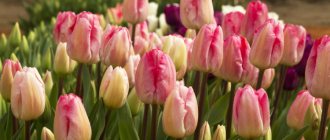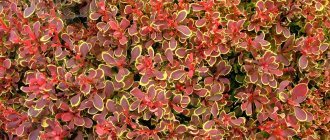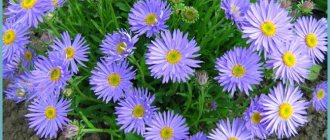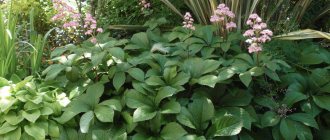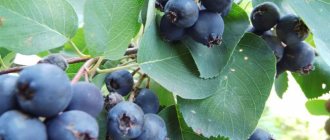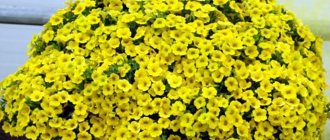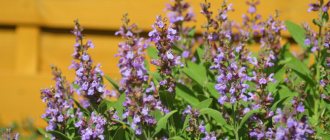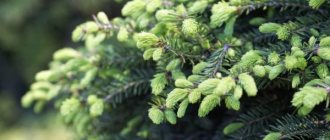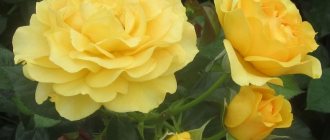General characteristics of Ottawa barberry
All varieties of barberry are grown most often for decoration purposes. The shrub reaches its main decorative value in the 6-8th year of cultivation. The plant begins to flower in mid-May and lasts about 3 weeks. The barberry bush has small, yellow flowers with a reddish tint. To bear fruit, barberry requires insects for pollination.
Fruiting of the bush occurs in the 6th year of life, depending on the variety, it lasts from August to September. The yield of an adult shrub is 11-13 kg. The fruits may hang until the beginning of winter. The lifespan of barberry is up to 50 years. With proper care, the bush bears fruit for about 40 years.
Pros and cons of the variety
The advantages of this type of barberry shrub include:
- increased growth rate, annual growths grow up to 35 cm long;
- unpretentiousness, the plant adapts well to different types of soil;
- resistant to drought, low light;
- rarely affected by harmful insects;
- rapid recovery of the plant after mechanical damage;
- with proper care and shelter it grows in the northern regions.
There is one disadvantage to this variety: it is characterized by average winter hardiness. Accordingly, there is a possibility of partial freezing of young shoots of the bush.
Varieties of Ottawa bush
Brought out in Canada by crossing the Thunberg barberry and the Ordinary variety. The natural habitat of the bush is along rivers, ravines, forests.
Auricoma
During the growing season, a neat compact plant is formed, reaching a height of 1.7 to 2.4 m. Large leaf blades of the shrub, after blooming, acquire a dark red color, and as autumn approaches they change to lighter orange shades.
Superba
Superba can reach a height of 2.4 to 2.9 m. The leaf blades have a dark red or purple color with a bluish tint.
Silver Miles
A spreading shrub, reaching a height of 2.1 to 2.7 m. The leaves of barberry are purple with a silvery tint.
Landing
The ideal option for cultivating barberry is to purchase a 2-3-year-old seedling. It is advisable to do this in a specialized store . The main characteristic of the quality of a seedling is that the root system must be at least 25 cm long, without signs of rot or mechanical injuries.
30 days before planting the barberry bush, it is important to dig up the area and clear it of weeds. Particular attention is paid to soil nutrition; it is necessary to add: potassium salt, superphosphate, compost or manure, lime (if the soil is characterized by excessive acidity).
The distance between plants is selected based on the purpose of planting. If it is necessary to form a dense hedge from living shrubs, 4 seedlings are planted per meter segment, for a more sparse planting - two seedlings.
To disembark you need:
- form a hole 40 by 40 cm;
- add a layer of fertile soil to the bottom;
- add fertilizer (slurry, potassium salt, ash), mix with soil;
- water;
- Place a barberry seedling in the middle of the hole so that the root collar does not deepen, taking into account subsequent shrinkage, it is located 3-4 cm above the ground plane;
- cover with fertile soil, compact, mulch with a layer of peat, chopped straw, and humus.
It is allowed to plant the bush in the spring before the buds swell, when the soil has thoroughly warmed up. In barberry, the growing season begins early; therefore, when planted in the spring, it is more difficult to take root. More favorable autumn planting, 25-30 days before the onset of frost. During this period, the plant’s root system will undergo adaptation and hardening, which will significantly increase winter hardiness.
Preparing for landing
Ottawa barberry is planted in the spring, after the soil has warmed up to +15 degrees, or in the fall, 3-4 weeks before the onset of frost. In spring, the plant takes root worse because its growing season begins early. And planting in the fall gives it the opportunity to strengthen until spring. Winter hardening will increase resistance to frost.
Seedlings for planting are purchased at 2-3 years of age, healthy, with long living roots and without signs of diseases and pests.
A month before planting, all weeds with roots are removed from the selected area. Dig the soil to a depth of 30 cm with an addition per 1 square meter. m. 10 g of potassium salt, 20 g of superphosphate, 10 kg of manure and 0.5 kg of lime if the soil is too acidic.
Further care of the plant
Compliance with the requirements for caring for a barberry bush is the key to the successful development of the plant.
Priming
This variety is unpretentious to the composition of the soil, but is sensitive to excess moisture. Accordingly, the presence of groundwater is taken into account; it must pass no closer than 2 m. Otherwise, it is recommended to lay out a high-quality drainage layer.
Location
The shrub loves areas with sufficient lighting, protected from draft winds. It grows well in shaded areas, but the color saturation of the leaves is reduced.
Watering
Watering the plant is carried out after each fertilizer and once every 7 days in dry weather. One bush needs, depending on age, from 6 to 9 liters. After the watering procedure, it is important to tidy up the mulch. The last watering of barberry is carried out in the autumn, 14-16 days before the onset of frost.
Top dressing
Nutrition after planting must be done in the spring of the next season. To stimulate vegetation, it is recommended to add urea at the rate of 35 g per 10 liters of liquid. Then it is fed with nitrogen every fourth year.
For abundant flowering and good ripening of new branches, it is necessary to feed them with organic matter: 1 kg of rotted manure, pour 3 liters of liquid and leave for three days. Next, dilute in the proportion: 1 (infusion) to 3 (water). To strengthen it before winter, it is necessary to add 13 g of superphosphate and 10 g of potassium sulfate.
Trimming
Since the barberry bush is an ornamental plant, pruning is necessary to maintain a decent appearance, and annually. It has two goals:
- Stimulation of the growth of new shoots, whose leaf plates are better decorative.
- Sanitation: necessary to eliminate unnecessary stress on the plant, prevent the spread of diseases, and damage from harmful insects.
Autumn pruning is sanitary. It is carried out at the moment the bush enters the dormant stage, as a rule, 15 days before the onset of the first frost. Considering the region of growth, these periods range from the end of September to the end of November.
Shrub pruning
Ottawa barberry is an ornamental deciduous shrub that requires annual pruning to maintain its beauty. This is done to stimulate the active growth of young shoots, which are distinguished by leaves of maximum decorativeness . The second purpose of pruning is sanitary; it is needed to remove excess load from the bush, prevent the development of diseases and pest damage.
In the fall, sanitary pruning is carried out . The procedure is carried out when the bush begins to enter a dormant state, at least 2 weeks before the first frost. Depending on the regional climate, pruning dates may begin in late September and last until the end of November.
It includes deletion:
- old and dried branches;
- areas affected by pests or rot;
- unnaturally intertwined branches;
- shoots growing inside the crown.
Sections are made only along the annular bead or above the bud with sharp and disinfected garden shears. Large wounds should be treated with garden varnish. After the procedure, all plant debris, mummified fruits and fallen leaves are disposed of .
Barberry Ottawa perfectly forms a crown in a natural way. This is facilitated by thin branches growing vertically upward at an acute angle. Therefore, with single plantings, you can only get by with sanitary pruning.
Pruning scheme and hedge trimming
Plants intended to form hedges will require regular trimming. In the second year after planting, barberry shoots are shortened by 1/3 or 1/2 . This will stimulate plant tillering. Barberry blooms on last year's growth. Therefore, so that the shoots with flower buds have time to grow, the procedure is carried out immediately after the bush blooms.
In the same way, barberry continues to be cut in subsequent years, until the crowns of neighboring bushes close together. After this, the lateral and upper growths are shortened twice a season. This creates flat edges of the hedge with a denser lower part.
The pliability of the Ottawa barberry allows many of the fantasies of landscape designers to come true. The bush can be shaped into a ball, a triangle, or a complex multi-tiered figure. At the same time, it is important to know that during the period of crown formation of 3-4 years, due to regular pruning, you will have to forget about the flowering of the bush.
Reproduction
Propagation of Ottawa barberry occurs in the following ways, each of which is characterized by its own pros and cons:
- Layering: Not all varieties of barberry produce layering.
- Dividing the bush: the risk of injury to the root system increases.
- Cuttings: adaptation and rooting occurs relatively slowly.
- By seeds: the germination rate of barberry bush seed material ranges from 20% to 40%; it is worth noting that the varietal characteristics of a new bush will not always be preserved.
Each gardener can choose the propagation method at his own discretion.
Reproduction methods
Adenium obesum - description and care at home
There are several ways to propagate barberry. Young plants can be obtained:
- from seeds;
- by cuttings;
- layering.
The last two methods give better results. It is possible to obtain seedlings from seeds only in half of the cases. Seed germination is only up to 45%. In addition, varietal qualities are not always preserved.
Shrub propagation
Cuttings are carried out in June, and layering is added in the spring. By autumn, a one-year-old shoot will take root and form a new bush.
About Ottawa barberry Superba: variety characteristics, planting and care
The barberry shrub is useful and decorative, but unpretentious in care. Notable for its beauty, it also produces edible fruits. Hedges from this crop will look very colorful, like other landscape compositions. Barberry Ottawa Superba (“Superba”) differs from other varieties in its large size, up to 4 m in height. Decorativeness is a quality that gardeners are increasingly paying attention to. The type of shrub in question fits all the characteristics necessary for successful site design.
Reviews
Natalia, Voronezh . Our plot is quite extensive, and most of it is occupied by a spacious lawn. On the advice of friends, we decided to plant barberries there. I really liked the Ottawa barberry variety “Superba”. They planted it in the fall, there were fears that it would not take root. However, 2 years have already passed, the bush is already more than a meter long and has not yet caused any problems.
Valentina, Saratov . Several years ago we decided to fence the perimeter of the site with a hedge. We spent a long time selecting plants; we wanted to achieve beauty and functionality. We chose the Ottawa barberry, planted it densely and cut it several times every year. I would like to say that out of several dozen plants, only one shrub did not take root. The rest developed well. Now these are almost two-meter plants that transform every season.
Diana, Pskov . Five years ago I first met Ottawa barberry during a trip to a sanatorium. I was impressed by the beauty of the leaves and fruits, and when I learned about the beneficial properties, I decided to plant them on my own plot. 5 years have passed since then. Low seedlings have turned into luxurious bushes that annually delight me with beautiful and healthy fruits. I make compotes, jams and preserves, add them to decoctions and tea.
The attractiveness of cultivating Ottawa barberry lies not only in the highly decorative nature of the plants. All parts of the bushes have medicinal properties and are widely used in folk medicine . Compotes, preserves and jams are made from barberry fruits, which can diversify any diet with their extraordinary taste.
Characteristics and Features
Barberry Thunberg Superba reaches a height of 3 meters (it is believed that up to 4 m). Usually it is formed into a plant with compact dimensions - 1.8-2.2 m. Large Superba barberry is susceptible to leaf fall. It grows quickly, reaching its height limit at 8 years or a little later. The shoots initially rush vertically, but then bend in an arc, a drooping line. The red-brown bark has thorns 2 cm long.
Barberry: varieties
The leaves are rounded up to 5 cm in length, dark red or purple in color even in the shade. As a result, the plant looks unusual, creating a decorative effect. In autumn the bush turns light red or orange. Flowering period is May. The inflorescences in the form of racemes are yellow in color, including about 10 pleasantly smelling flowers.
Interesting. After the first frost, the fruits lose some of their bitterness and acidity. In this regard, they are in no hurry to collect them.
The characteristics of the berries are scarlet color when formed, as well as an oblong shape, up to 1 cm long. Ripening is observed between September and October. The shiny fruits have a sour taste and can remain on the branches for a long time. They are very useful, not only edible, but also a medicinal plant and a culinary seasoning. Suitable for jelly, compotes, jelly.
Description of the plant
Ottawa barberry is native to the forests of North America. This deciduous shrub belongs to the genus Barberry, the Barberry family. This variety was obtained by crossing Thunberg barberry and common barberry in 1889 in Ottawa.
The bush grows to a height of 2 m; the shoots have a few soft thorns. The growth of shoots per year is 35 cm. The shrub reaches its best appearance at the age of 6-8 years. The leaves are obovate, up to 3.3 cm long, and acquire a yellow or crimson tint in autumn.
The flowering period falls in May and lasts 3 weeks; the flowers are yellowish in color, arranged in inflorescences of 10 pieces, and emit a strong aroma. Pollination of barberry flowers occurs with the help of insects. Barberry flowers are honey plants and attract many bees and bumblebees with their aroma.
The fruits are oblong, bright red in color, they are edible, but sour in taste, and ripen from mid-August to early September. Fruiting occurs 5-6 years after planting. From one adult bush you can collect about 10-13 kg of berries. With good care, a barberry bush can bear fruit for up to 35-40 years.
Ottawa barberry is famous for its unpretentiousness and tolerance to drought, shade, air pollution, and undemandingness to soil quality. It tolerates pruning well and grows quickly.
Features of cultivation
Landing
Cultivation begins with planting, during which it is important to choose the right season and location. Favorable times are spring and autumn. In the first case, wait for the soil to warm up to +15 °C and try to prevent the buds from blooming. In the fall, it is important to plant Superba Ottawa barberry 3 or 4 weeks before the onset of frost. The following rules are observed:
- autumn planting is preferred;
- choose an open space or partial shade, a place protected from strong winds;
- take into account the acidity of the soil: if it is above pH 7, lime.
Barberry Thunberg Aurea
Prepare a mixture of turf, humus, peat, wood ash mixed with soil. All this is filled with water. Dig a hole 0.4 by 0.4 m. The distance between the bushes is from one and a half to 2 meters. When creating a hedge, place 2 plants per 1 meter. The bush is placed in a hole so that the root collar is flush with the surface, and covered with a fertile mixture.
Application in landscape design
Barberry Superba is grown mainly for decorative purposes. This shrub is well suited for creating hedges. It can be given various shapes, creating complex, multi-tiered figures.
From Superba barberry you can create not just hedges, but entire labyrinths
The variety can be used for both single and group plantings. In the second case, it must be placed in the background.
If you form the crown of Superba barberry, then during this period there will be no flowering for 3-4 years due to pruning
Barberry Superba goes well with plants colored in various shades of green
Barberry Superba is combined with various conifers, especially with bluish or gray needles
Advantages and disadvantages of the variety
Barberry Thunberg Rose Glow
Good and bad qualities can be learned from reviews from gardeners. Note:
- survival rate;
- beauty;
- functionality as a hedge;
- the possibility of using berries as a food product;
- presence of beneficial properties in fruits;
- there is no excessive demand on the soil;
- resistance to cold, wind, drought, smoke.
There are practically no bad qualities noted.
There are other varieties of decorative barberries. For example, Silver miles (Silver Miles), which is slightly smaller in size, has burgundy leaves with purple and silver tints. By following the rules of care, it will not be difficult to grow decorative barberries that produce an edible harvest. It is an essential element of garden design, used for plantings and hedges.
Barberry Superba: planting and care, photo
Ornamental shrubs can decorate even the most modest garden plot. Barberry Superba is a fast-growing perennial that not only has tasty fruits, but also has a rather attractive appearance.
Every gardener dreams of planting barberry bushes, because bright plants can create a colorful landscape composition in any garden. Knowing the nuances of planting and the rules for placing shrubs on the site, you can make caring for plants easier.
Description of barberry Superba
Barberry Superba grows as a large spreading shrub. The plant reaches its final size in 9 years. Barberry bushes are used for group plantings; single planting on a site is often practiced. The flowering period of the perennial plant is May-June.
Superba barberry flowers have a pleasant scent and are collected in neat racemose buds. There are up to 10 pieces on 1 brush. The color of the flowers is yellow with a reddish tint, length – 4 cm.
The crown is large and spreading, forming long growths over the years. At the beginning of growth, the branches are directed upward, and over time they stretch in wide arcs. The plant forms many branches on which there are sharp thorns.
The foliage of the Superba variety is round in shape, up to 4 cm long. The color of the green mass is purple-violet, with a grayish tint in summer. In spring, most leaves turn red.
Advice! When planting the Superba variety in a well-lit area, the leaves will appear much brighter.
The berries of barberry Superba are elongated, deep red in color, located on drooping branches. They are sour in taste and have a fairly pronounced aroma.
Botanical description
Today there are more than 170 species of barberry shrubs in the world, planting and caring for which is not difficult even for a novice gardener. Some plants are semi-evergreen creeping shrubs, others are evergreen, and others are deciduous. The leaves of the shrub can be alternate, simple or leathery. By the way, few people know, but barberry spines are also leaves, but in a modified form, consisting of one vein, pointed at the end. Below is a photo of a barberry bush grown in Russia.
Yellow-golden or orange-red barberry flowers are small in size but have a rather fragrant aroma. In most cases, they are collected in corymbose or racemose inflorescences, but they can also be solitary. The plant is an excellent honey plant, which attracts bees from all over the area. Depending on which variety is used for cultivation, the fruits will differ in color and shape. However, they all have a lot of useful properties, since they contain a large number of microelements and vitamins. Because of this feature, the fruits of the barberry bush, the photo of which is given above, are widely used in traditional and folk medicine. Preparations based on these berries help get rid of many diseases.
Planting and caring for barberry Superba
A perennial shrub does not require special planting conditions. The plant is more suitable for slightly acidic and alkaline soils. Barberry of this variety tolerates sudden changes in weather conditions well and is not afraid of long-term lack of watering.
Maintenance measures are standard: regular pruning and preventative spraying against insect pests.
Preparing seedlings and planting area
In order for the plant to form beautiful and long branches, it is important to prepare the right soil. The Superba variety is often planted in a pre-prepared soil mixture:
- humus;
- turf soil;
- sand.
All ingredients are mixed in equal proportions.
Important! The optimal acidity of the soil for planting will be 6.5 pH.
If planting is done in acidic soil, liming is necessary. For 1 plant take 35 g of slaked lime.
It will be important to prepare the seedling for planting. Before the procedure, the root is dipped into a growth stimulator. You can purchase this product at any garden store.
If planting material is purchased on the market, you should carefully inspect it. The seedling should not be damaged and the root system should not be overdried.
When preparing material for planting yourself, shoots of a perennial shrub with a strong, well-developed root system are taken.
Planting barberry Superba
Superba bushes love well-lit places. In them the plant will have bright colors. If barberry is intended to be planted in single plantings, it is recommended to make holes measuring 60 by 60 cm. When planting in groups, the minimum distance between bushes should be at least 40 cm.
Algorithm for planting barberry Superba:
- Dig deep holes.
- Place drainage stones or sawdust on the bottom.
- Add fertilizing: peat, humus.
- Lower the young seedling into the hole so that 2 cm of the root collar are above ground level.
- Provide abundant moisture to the plantings.
- Loosen the soil.
Watering and fertilizing
The perennial Superba practically does not require any special rules for fertilizing. They are brought under the bushes 1 year after planting. For the first feeding, urea is used. All subsequent fertilizers are applied once every 4-5 years.
It is worth noting that the shrub practically does not require watering. Often, young shoots that have a poorly developed root system need moisture. During the summer there will be quite a bit of rain. However, during prolonged drought, the shrubs should be provided with the necessary amount of liquid.
Attention! Barberry Superba does not like stagnant moisture, so you should be careful with watering.
Trimming
Prune the bush in early spring. This event is a prevention of many diseases. Old, frozen and damaged shoots must be removed. It is not recommended to form a plant if there are many internodes on the bushes.
Advice! To maintain a decorative crown, it is enough to rejuvenate the bush with light pruning.
It is worth noting that shoots that have stopped growing are also subject to removal. Old plants also need to be thinned out in the spring.
The first preventive pruning is carried out 2 years after planting. During this period, the lower shoots are cut off. Further pruning is carried out 2 times a year: the first in summer, the second in early autumn.
Preparing for winter
Young bushes under 3 years old need preparation for winter. In the first years of life, it is necessary to cover the plantings with spruce branches. Further preparation for frost involves preventative pruning carried out the day before.
Advice! If severe frosts are expected, it is necessary to cover the plant with clods of snow.
Reproduction
You can propagate the Superba barberry bush in 3 ways. The plant almost always takes root well. Each summer resident chooses a plant propagation method that is more convenient for him.
Reproduction methods:
- by dividing the bush. To perform this method, the young shoot is separated along with the root and planted in previously prepared soil;
- green layering. A good and strong shoot is identified on the bush, which is pressed tightly to the ground and covered. The plant is watered abundantly until the branch gives root;
- cuttings This method is easy to use. It is enough to find young strong shoots on the bush that need to be cut with a knife. The shoots are planted in prepared flowerpots and watered well. After the plant has developed a strong root system, it is transplanted into the ground.
Diseases and pests
Barberry Superba is susceptible to damage by barberry aphids and powdery mildew. To prevent bush disease, it is important to perform preventive pruning and treatment with special means. With proper care, the plant can develop good immunity, which will help avoid problems with care.
In case of illness, you should purchase special preparations at a garden store and carry out therapeutic spraying. To combat aphids, use a 0.2% solution of “Fitoverma”; if barberry is affected by powdery mildew, use “Fundazol”. Bordeaux mixture is used to treat rust.


